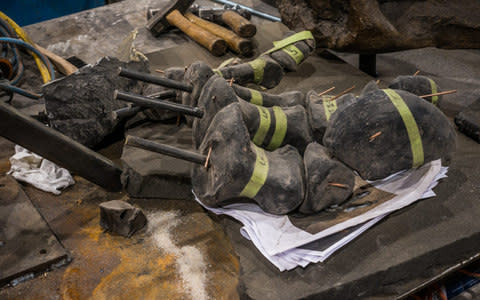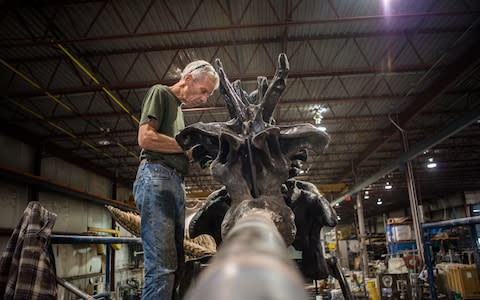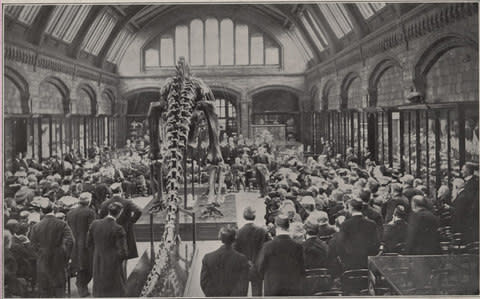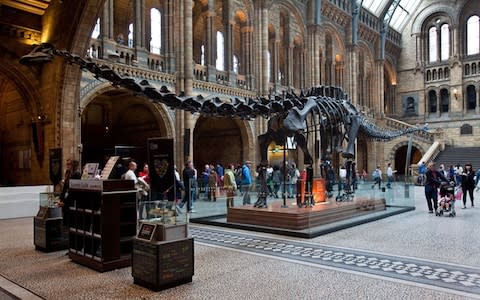Dippy the Dinosaur to return to Britain...with brand new hands
For more than 100 years, Dippy the Dinosaur stood solidly on his four feet, greeting visitors at London’s Natural History Museum until he was replaced earlier this year.
But when he returns to Britain next year following extensive restoration work in Toronto, Canada, two of his feet will have vanished.
Dinosaur experts at the NHM are using the opportunity to finally correct a major error that was made when the diplodocus was first assembled a century ago, ahead of a nationwide tour.
Dippy is being given hands.
Although it may seem that a lumbering diplodocus should have four feet, like quadrupedal mammals do today, in fact the dinosaur distributed most of its weight in its back legs and tail, using its front hands merely as tip-toeing guides.

Professor Paul Barrett, the museum’s dinosaur expert, said: “Dippy is actually five different sauropods, cobbled together, but they never had diplodocus hands so they just made copies of the feet. Dippy would have walked on the tips of his fingers in a sort of graceful ballet step.
“When you see diplodocus footprints they are actually very deep at the back, but you see half moon shapes at the front, because the whole weight of the foot didn’t go down.
“Dippy is a plaster cast, but we’re taking care of him as if he’s an original fossil. If anything it’s harder than a real fossil because it’s more fragile. The plaster has become crumbly as its dried over time.”

Dippy is a replica of a near-complete Diplodocus carnegii skeleton uncovered in the western USA in 1898.
He was given to the museum by Scottish-American industrialist Andrew Carnegie after King Edward VII saw an illustration of the original skeleton, which was at the Carnegie Museum of Natural History, Pittsburgh, and requested a copy.
It took 18 months to make the cast. After its completion in 1904, Dippy was shipped to England in 36 crates and unveiled in 1905. The dinosaur will be returning to Britain across the Atlantic in January in 32 crates.

Since the 1960s ‘Dippy’s posture has been changed twice to recognise changes in scientific thinking about how the dinosaur would have stood. His head has been raised and tail lifted off the ground to reflect a sauropod's wider range of movement. Dippy’s new hands, and slightly tipped back posture will give the dinosaur his most accurate stance yet.
Lorraine Cornish, our Head of Conservation, who is in charge of building and rebuilding Dippy at each of the eight venues said: “He is now being cleaned up and mounted on a new plinth so that he will be much safer and easier to take apart and put back together again.
“There has been quite a lot of conservation work on the plaster because it dates from 1905. Visitors were quite fond of touching Dippy, so some parts are wearing away, particularly around the tail and his toes. We used to keep spare tail parts and toes in case they needed replacing.”
Dippy has never been on public display outside of London before but for the next two years will travel the length and breadth of the country
The dinosaur will be touring the Dorset County Museum, Birmingham Museum, Ulster Museum, Kelvingrove Art Gallery and Museum Glasgow, Great North Museum Newcastle, National Assembly of Wales, Number One Riverside Rochdale, and Norwich Cathedral.
The tour has been organised to also mirror the grand sweep of geographical time across Britain, as he journeys from the Jurassic Coast, finally arriving in Norwich, whose exhibition will explore how to secure a sustainable future for the world’s wildlife.

“The venues we have picked are all very different so you will be able to see Dippy in everywhere from a cathedral, to the Welsh national assembly,” added Mrs Cornish. “He’s part of the national collection, so be belongs to the nation so it’s right that as many people as possible can see him. We hope it will inspire future generations.”
Dippy lived between 156 and 145 million years ago and weighted around 13 tonnes.
The huge dinosaur cast which is 68 feet long (21.3m) 14 feet wide (4.3m) and 13 feet high (4.25)has not been seen since it was dismantled from Hintze Hall on 4 January this year.

But visitors to the Natural History Museum who are missing Dippy will not have to wait too long to see him again. The Museum is planning a life size replica statue to stand outside the building.
In the summer an 82 feet (24m) whale skeleton called Hope was hung in Hintze Hall to replace Dippy.

 Yahoo News
Yahoo News 